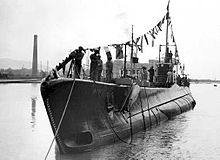Bordeaux submarine bunker

The submarine bunker Bordeaux ( French Base sous-marine de Bordeaux ) was a protected submarine base of the German and Italian navies during World War II in Bordeaux, southern France . The base was subordinate to the German commander of the submarine fleet Karl Dönitz .
Building the base
Cooperation between the Axis and Marines began after the steel pact was signed in June 1939 with a meeting in Friedrichshafen and an agreement reached on the exchange of technical information. After the Italian entry into the war and the fall of France, the Italian Navy established a submarine base in Bordeaux , which was within the German occupation zone. The Italians were assigned an area of operations within the Atlantic south of Lisbon . The base opened in August 1940, and in 1941 the captured French passenger ship De Grasse was used as a depot ship before being returned to the French government of Vichy in June 1942 . Admiral Angelo Parona commanded the Italian submarines of the BETASOM mission under the command of the German Admiral Karl Dönitz. Dönitz was the commander of the submarines for the German Navy. About 1,600 Italian marines were stationed here. Betasom is short for Bordeaux Sommergibile in Italian . The base could accommodate up to 30 submarines, had dry docks and two basins connected with locks. The nearby barracks housed a 250-strong guard regiment.
The bunker construction
Due to the increasing threat to the base from Allied air raids, Admiral Dönitz decided in the summer of 1941 to build a submarine bunker for the base in Bordeaux. Construction began in September 1941. The bunker was made of reinforced concrete. It was 245 m wide, 162 m long and 19 m high, with a roof over the submarine bays 5.6 m thick and 3.6 m thick over the rear maintenance area.
On October 15, 1942, the German 12th submarine flotilla was set up in Bordeaux by the Navy under the command of Corvette Captain Klaus Scholtz . The first German submarine to use the bunker was U 178 on January 17, 1943 .
The end of the use of the bunker in World War II
The base was bombed several times by the British, especially in 1940 and 1941, but no major damage was done except for the sinking of the Usaramo barracks ship. The base was indirectly attacked by the British Operation Josephine B in June 1941, an air raid on the substation that served the base.
The remaining Italian BETASOM boats ended their missions in the late spring of 1943. After that, seven BETASOM submarines were used for the transport of essential war materials from the Far East ( Alpino Attilio Bagnolini , Agostino Barbarigo , Comandante Alfredo Cappellini , Giuseppe Finzi , Reginaldo Giuliani , Enrico Tazzoli and Luigi Torelli ). Two of them were sunk by the Allies, two were captured in the Far East by the Germans after the Italian surrender in September 1943 and used by them. A fifth boat was captured by the Germans in Bordeaux, but not used.
After the Italian armistice in September 1943, the Italian part was occupied by Germans. Some of the Italian staff joined the Germans.
The last two remaining German submarines left the submarine bunker in Bordeaux in August 1944, three days before the Allies occupied the base on August 25, 1944. The last remaining German naval personnel attempted to withdraw to Germany and were captured by Allied forces in southern France on September 11, 1944.
Post-war use of the submarine bunker
After the war, the submarine bunkers proved to be non-demolishable due to their massive reinforced construction. Since 2010, after the conversion a few years ago, around 12,000 m² of the 42,000 m² building has been open to the public as a cultural center for the performing arts, exhibitions and evening events.
literature
- Lars Hellwinkel: Hitler's Gate to the Atlantic - The German Naval Bases in France 1940–1945. Ch. Links Verlag, Berlin 2012, ISBN 978-3-86153-672-7 .
- Janusz Piekałkiewicz: Sea War: 1939-1945. Blandford Press, London - New York 1987, ISBN 0-7137-1665-7 .
- Cristiano D'Adamo: The Bombardments of Bordeaux and the Italian submarine base "BETASOM". REGIAMARINA, 1996-2007.
- Foot, MRD (1966): SOE in France. HMSO. Pp. 157-159.
- Alberto Rosselli: Italian Submarines and Surface Vessels in the Far East: 1940-1945. Comando Supremo.
- Clay Blair: Hitler's U-boat War: The Hunters, 1939–1942.
Web links
Individual evidence
- ↑ German submarine bunker as an attraction. n-tv.de
- ↑ BETASOM, acronym for Bordeaux Sommergibile , where B is replaced by Beta and the first syllable of sommergibile (it. = Submarine) is appended. [1]
- ^ Foot, MRD (1966). SOE in France. HMSO. Pp. 157-159.
Coordinates: 44 ° 52 '11.9 " N , 0 ° 33' 31.2" W.

